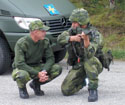 |
| Swedish army vehicles move in a multinational convoy in the Mazar-e Sharif region of Afghanistan. In a shift from longtime policy, Swedish military forces are taking an active role in multinational operations far away from their homeland. |
Generations of domestic defense give way to an out-of-area focus.
Long-neutral Sweden faces major defense changes as it shifts its military emphasis from homeland defense to coalition operations. A force built around defending the territory of a single Scandinavian nation now must open up to interoperate fully with other nations in distant locales. This is bringing about changes in funding, logistics and force size.
Traditionally, Sweden has been nonallied, and its defense posture has had a strong territorial focus. But the end of the Cold War changed Sweden’s defense outlook, and in the mid-1990s it began taking part in more peace-support missions beyond its borders. While the country had participated in many United Nations (U.N.) peacekeeping operations, the focus on Sweden’s out-of-area military operations changed from U.N. missions to coalition operations with like-minded countries.
“Sweden today is an active partner in international operations,” declares Lt. Gen. Mats Nilsson, SAF, chief of staff, Swedish armed forces, and commander, armed forces headquarters. “We have a very clear designation from our political leaders to be a professional contributor, together with other countries, in fulfilling the missions we see together in the world.”
Domestic political decisions codified the focus away from the traditional purely territorial defense to involvement in foreign operations. The past five years have seen this trend accelerate, Gen. Nilsson relates, with a December 2004 bill passed by the Swedish parliament providing a major shift toward newer types of operations. The Swedish armed forces have been reduced substantially both in raw numbers and in the size of their organizations.
Swedish forces now operate on three continents under U.N., NATO and European Union (EU) commands, the general observes. These efforts include responsibility for one of the provisional reconstruction teams in northern Afghanistan, the lead in a multinational task force center in Kosovo and participation off the coast of Lebanon with naval vessels in the United Nations Interim Force in Lebanon (UNIFIL) mission.
“We can foresee that smaller countries have to be able to work together even more in the future,” Gen. Nilsson states. “We—all of us—can’t do everything separately. More work will be done jointly among different nations.”
Sweden joined the EU in 1995. With the EU striving toward its own defense identity, the country is an active partner in the European Security and Defense Policy (ESDP) program. The EU has established battlegroups that will maintain high readiness for a variety of missions, and Sweden has framework nation responsibility for the Nordic Battlegroup. In addition to Sweden, this group comprises Finland, Norway, Estonia and Ireland. The EU keeps two of its battlegroups on six-month standing alert at any given time, and the Nordic Battlegroup will assume alert status at the start of 2008.
“That is quite a challenge and a new way of doing business for the armed forces of Sweden,” Gen. Nilsson imparts. “It really puts some momentum in the transformation of our armed forces.”
He continues that Sweden’s role in the Nordic Battlegroup has worked as a catalyst for some of the transforming challenges it faces. For example, it has forced Sweden to ensure that it has modular units that are interoperable. These plug-and-play units need not be a full brigade or battalion, but they must be able to form up to battlegroup size.
 |
| Gen. Nilsson (l) chats with a Swedish soldier during an exercise. Amid shrinking resources, Sweden must continue to attract skilled people for its armed forces to maintain quality as it expands its interoperability. |
The new out-of-area emphasis affects military personnel policy. Instead of all of
Sweden’s armed forces being stationed in defense of the homeland, forces now may face deployments that could change suddenly. The logistics of where to base these forces that could be sent anywhere also are complicated compared to
Sweden’s traditional patterns.
Amid these dramatic changes to its armed forces, Sweden’s total armed forces budget actually is dropping substantially—about 8 percent since the 2004 defense bill. The country is closing bases and eliminating forces. Agencies supporting the armed forces were particularly hard hit to cut overhead. Gen. Nilsson points out that these cuts mandate better efficiencies.
For training, materiel and research and operations, Sweden spent nearly 40 billion kronor ($6 billion) in 2005. That amount is planned to decline to about 37 billion ($5.5 billion) each year in 2007, 2008 and 2009, with most of that reduction taking place in training and planning.
But the transforming force that is adjusting to new missions is seeing many of its expenses rise, the general adds, especially as foreign deployments add to operational costs. Sweden tries to ensure that specific units are fully trained and equipped for potential deployments, and this affects budget distributions from year to year. Gen. Nilsson foresees a continued increase in spending on operations.
This would mean that materiel and research also should take a budgetary hit. However, this is mitigated by Sweden’s longtime tradition of building systems of systems with a national focus. For example, it networked its Gripen fighter aircraft with its national air defense system to generate a common operating picture for shared situational awareness across service lines. These advanced tactical datalinks did not work south of the Baltic, however (see page 35).
Now, Sweden is applying its philosophy toward technical interoperability with NATO forces. Since 2000, Sweden has recognized that interoperability must be ensured technically, organizationally and doctrinally, the general declares. Decisions made in that time frame focused on achieving NATO interoperability as a cornerstone of Swedish military operations.
“Sometimes we are told that we are more interoperable with NATO than are many NATO countries,” Gen. Nilsson relates.
He continues that Sweden interoperates very well with other countries in training missions. However, Sweden is a partner, not a full member, of the Atlantic alliance. That often requires the country “to do things in a little bit more bureaucratic way,” the general allows.
A nation’s military interoperability varies among NATO, coalition and national forces. Alliance standards can be different from those of many of its member countries, which often differ individually. Gen. Nilsson explains that the most important priority for Sweden’s interoperability is to be able to work among countries with which it is likely to conduct operations. These include the United States, the United Kingdom, Germany and France, to name a few.
When Sweden introduced its Gripen fighter aircraft more than a decade ago, the jet was treated as a node in an information network—an approach that other countries now are adopting. Gen. Nilsson offers that Sweden is fairly advanced in network-centric operations, particularly since a 2001 assessment that convinced planners to improve force networking.
Traditionally, the separate services performed their own networking individually, which led to disparities in both the type and the degree of networking. Sweden adopted a joint approach following the 2001 assessment, with many of its efforts focusing on tests and demonstrations. Last year marked the conclusion of a three-year plan that included work with other countries.
“Today, we have a fully joint approach to networking,” he elaborates. “It’s not service networks, it’s a joint network. We have to be able to communicate with different platforms and sensors in all different aspects. And, [the network] must be plug-and-play with other countries as much as possible.”
As it strives for joint interoperability, Sweden is working with NATO on networking within the alliance. Gen. Nilsson relates that a couple of years ago he was concerned that Sweden’s own thrust toward interoperability might preclude it from coalition operations, particularly as other countries pursued different tracks for interoperating. So, Sweden is working hand-in-hand with other countries on the way ahead.
“We are now ready with our thinking, we are ready with our testing, we are ready with our demonstrations, and we know where we are going,” the general continues. “But it is no use for Sweden to do it alone, so now we are working actively in different working groups within EDA [European Defense Agency] and NATO C3 [consultation, command and control] boards to make sure that we all are on the same track.
“But the goal is very clear: You have to be able to use different platforms and network everything together to make sure that you get as much out as possible,” he declares.
As are many other advanced Western militaries, Sweden is striving to push the network down to the individual warfighter. But Gen. Nilsson warns against being overly ambitious, preferring instead to take a pragmatic approach to warfighter networking. “Don’t overload the man all the way at the bottom,” he cautions. “Make sure he gets the information needed to fulfill his mission and his tasks—that probably is the trickiest part ahead of us.”
Nontechnical challenges remain. Sweden must continue to ensure that it has the necessary skilled people in its ranks, the general notes. The military competes with the commercial marketplace for personnel, and the government must convince 20-year-olds that it is the type of organization that they want to join.
Logistics are another key issue. With its forces now committed to out-of-area operations, Sweden must deal with strategic transport and support. Instead of operating in a fully developed nation with familiar resources at hand, Swedish forces may find themselves in a strange land with a poor or even backward infrastructure. The lack of extensive expertise in this realm is compounded as Sweden’s forces transition to an expeditionary nature.
And, as with other nations, Sweden must examine its capabilities and make strategic decisions about which ones to choose for the future. This involves combining short-term operational requirements with long-term requirements and stability. Many nations face the challenge of supplying for today and planning for tomorrow, but the general points out that Sweden’s small size gives it fewer options and makes these decisions more important.
Web Resource
Swedish armed forces: www.mil.se






Comments